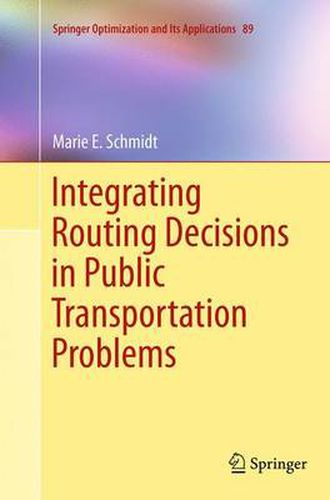Readings Newsletter
Become a Readings Member to make your shopping experience even easier.
Sign in or sign up for free!
You’re not far away from qualifying for FREE standard shipping within Australia
You’ve qualified for FREE standard shipping within Australia
The cart is loading…






This title is printed to order. This book may have been self-published. If so, we cannot guarantee the quality of the content. In the main most books will have gone through the editing process however some may not. We therefore suggest that you be aware of this before ordering this book. If in doubt check either the author or publisher’s details as we are unable to accept any returns unless they are faulty. Please contact us if you have any questions.
This book treats three planning problems arising in public railway transportation planning: line planning, timetabling, and delay management, with the objective to minimize passengers’ travel time. While many optimization approaches simplify these problems by assuming that passengers’ route choice is independent of the solution, this book focuses on models which take into account that passengers will adapt their travel route to the implemented planning solution. That is, a planning solution and passengers’ routes are determined and evaluated simultaneously.
This work is technically deep, with insightful finding regarding complexity and algorithmic approaches to public transportation problems with integrated passenger routing. It is intended for researchers in the fields of mathematics, computer science, or operations research, working in the field of public transportation from an optimization standpoint. It is also ideal for students who want to gain intuition and experience in doing complexity proofs and designing polynomial-time algorithms for network problems.
The book models line planning, timetabling and delay management as combined design and routing problems on networks. In a complexity analysis, the border between NP-hard and polynomially solvable problems is illustrated. Based on that, the insights gained are used to develop solution approaches for the considered problems. Besides integer programming formulations, a heuristic method iterating planning and routing step is proposed to solve the problems.
$9.00 standard shipping within Australia
FREE standard shipping within Australia for orders over $100.00
Express & International shipping calculated at checkout
This title is printed to order. This book may have been self-published. If so, we cannot guarantee the quality of the content. In the main most books will have gone through the editing process however some may not. We therefore suggest that you be aware of this before ordering this book. If in doubt check either the author or publisher’s details as we are unable to accept any returns unless they are faulty. Please contact us if you have any questions.
This book treats three planning problems arising in public railway transportation planning: line planning, timetabling, and delay management, with the objective to minimize passengers’ travel time. While many optimization approaches simplify these problems by assuming that passengers’ route choice is independent of the solution, this book focuses on models which take into account that passengers will adapt their travel route to the implemented planning solution. That is, a planning solution and passengers’ routes are determined and evaluated simultaneously.
This work is technically deep, with insightful finding regarding complexity and algorithmic approaches to public transportation problems with integrated passenger routing. It is intended for researchers in the fields of mathematics, computer science, or operations research, working in the field of public transportation from an optimization standpoint. It is also ideal for students who want to gain intuition and experience in doing complexity proofs and designing polynomial-time algorithms for network problems.
The book models line planning, timetabling and delay management as combined design and routing problems on networks. In a complexity analysis, the border between NP-hard and polynomially solvable problems is illustrated. Based on that, the insights gained are used to develop solution approaches for the considered problems. Besides integer programming formulations, a heuristic method iterating planning and routing step is proposed to solve the problems.